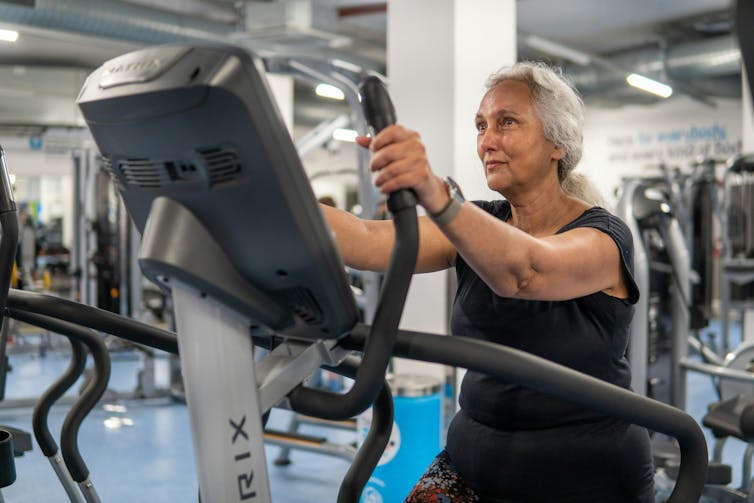Source: The Conversation – Canada – By Darby M. Babin, PhD Candidate, L’Université d’Ottawa/University of Ottawa
Were you expecting Fit for TV: The Reality of the Biggest Loser to peel back the curtain and provide hard-hitting truths on what really happened on the show that captivated millions in its heyday?
Well, uh, fat chance.
Instead, the three-part Netflix documentary, released mid-August, seems to traffic in some of the same problematic aspects of the show that spurred the need for an exposé in the first place.
Best of intentions?
This purported tell-all documentary — billed as exposing the truth of The Biggest Loser — is a bit of a nothing burger. There is no groundbreaking admission from the producers of the reality show that it shamelessly exploited fat people.
Instead, viewers are told the show’s creators had only the best of intentions and that it was just an unfortunate accident that things got out of hand when the trainers — Jillian Michaels and Bob Harper — took their roles too seriously.
The focus, for example, shifts to Michaels’ alleged failings, like providing contestants with banned caffeine pills. Michaels has refuted those claims and threatened legal action against Netflix.
Dr. Robert Huizenga, the show’s medical director tasked with overseeing the contestants’ health and well-being, is cast as the embodiment of concern and the voice of reason. Michaels is portrayed as the main villain while Harper gets off relatively scot-free. To elicit sympathy for him, we are reminded of his heart attack — so out of character for such a fit guy, of course.
The fatphobia problem
This is the fatphobic myth: bad health happens only to bad (see: fat) people, like the ones who auditioned to appear on The Biggest Loser. People like Harper should be safe from illness because they have lived lives worshipping at the altar of the fitness goddesses.
All the tropes about fat people lacking will power and being “lazy” (a term loaded with ableism) coalesce in this two-hour watch.
A welcome breath of fresh air is provided by Aubrey Gordon, a razor-sharp fat activist who writes under the moniker, Your Fat Friend. Her thoughtful critique is accessible to viewers who are less familiar with fat studies. And with her first appearance, she reminds us that what the show markets as its inspirational ideology differs in practice both on screen and behind when she remarks: “I’ll tell you what I think the show thinks it’s about…”
Gordon also challenges The Biggest Loser‘s overarching message by highlighting Harper’s heart attack. She says: “It sort of punctures one of the main arguments of the show, ‘If you’re fat, you’re going to die.’ And if you exercise ‘correctly,’ as determined by Bob and Jillian, all of these health outcomes will be warded off.”
Gordon’s observations are as close as the series gets to truly examining the fatphobia at the heart of the reality show.
The racism problem
Joelle Gwynn, who joined the show with friend Carla Triplett in 2009, is the only person in the documentary to openly raise concerns about race. She mulls over feeling as though the producers and fellow contestants were trying to frame her as the “angry Black woman.”
The angry Black woman trope is tied to what race, gender and class scholar Patricia Hill Collins calls “controlling images” of Black women, in particular the Sapphire, the Mammy and the Jezebel. These images are intended to demean, dehumanize and punish Black women in the name of white supremacy. The angry Black woman is the Sapphire’s contemporary, described by The Jim Crow Museum as “rude, loud, malicious, stubborn and overbearing.”
Triplett was perceived as more committed and jovial. When the pair was eliminated, Triplett was offered apologies while Gwynn faced hostility.
Indeed, as the producers confirm on the documentary, they sought out people who were downtrodden. In executive producer JD Roth’s own words: “We were not looking for people who were overweight and happy. There’s a lot of ’em. That’s fine. We were looking for people who were overweight and unhappy.”
Gwynn was too willful, unwilling to accept the treatment that the show seemed to believe she deserved by virtue of her fat, Black body. During one of her interview segments in Fit for TV, Gwynn looks directly into the camera after she shares a difficult memory of Harper berating her and says: “Fuck you, Bob Harper.” Somebody had to say it.
Of course, fatphobia and racism are deeply intertwined. As Sabrina Strings explains in her book Fearing the Black Body: The Racial Origins of Fat Phobia, anti-fatness emerged through chattel slavery when colonizers realized they had fat bodies in common with those they enslaved. This similarity was incompatible with their beliefs about superiority, so they mobilized chattel slavery and eugenics to tie anti-fatness to Blackness.
The misogyny problem
Perhaps the most puzzling case is that of Tracey Yukich, who made a dramatic entrance in Season 8 when she collapsed during her first running challenge and was hospitalized and diagnosed with rhabdomyolysis (an injury where muscle tissue breaks down).
Yukich explains that the reason she was willing to push herself so hard was her belief that weight-loss would improve her abusive marriage. She shares that the infidelity and abuse in her relationship felt inseparable from her weight gain and that the show was her opportunity to turn things around.
It is difficult to watch as there is no onscreen evidence to suggest Yukich ever received support from anyone at The Biggest Loser about the abuse in her marriage.
For all the talk about health in the reality show, Yukich’s mental health didn’t seem a priority. Instead, the doctor acts as counsellor and encourages Yukich to use the show as a second chance. Unable to exercise, however, she followed in the footsteps of other contestants who reduced their caloric intake to 800 or less — in other words, starvation.
The individual problem
A hyper-focus on individual responsibility is embodied in the entrepreneurial contestants who jockeyed for a spot on the show. The promise of freedom from fat is intoxicating.
The collective fascination with weight loss under the contradictory “weight” of liberalism, as critical food scholars Julie Guthman and Melanie DuPuis so aptly put it, reminds us that we live in societies that exhort us to consume more and eat less.
This, Guthman and DuPuis argue, “produces contradictory impulses such that the neoliberal subject is emotionally compelled to participate in society as both out-of-control consumer and self-controlled subject.”
The Biggest Loser reflects this neoliberal paradox of consumption and restraint: contestants were berated during exercise and told to try harder, yet given temptation challenges with desirable foods that tested their ability to resist so-called bad eating habits.
Who is the biggest loser?
More than a decade later, viewers are left to wonder, in the age of wall-to-wall weight loss drugs such as Ozempic, have we really moved the needle?
Is it surprising that when we paused viewing, a Dairy Queen ad popped up beside the cover image of the documentary? Like The Biggest Loser, it seems society and entertainment industries, bolstered by advertising, want both our self-control and our consumption.
And if we fail to appreciate that the media spectacle of weight loss is as grotesque as the profits made from weight-loss products, then maybe “the biggest loser” is us.
![]()
Darby M. Babin receives funding from the Social Sciences and Humanities Research Council of Canada
Michael Orsini receives funding from the Social Sciences and Humanities Research Council of Canada
– ref. Is the ‘Biggest Loser’ documentary entangled in its own internalized fatphobia? – https://theconversation.com/is-the-biggest-loser-documentary-entangled-in-its-own-internalized-fatphobia-264752










